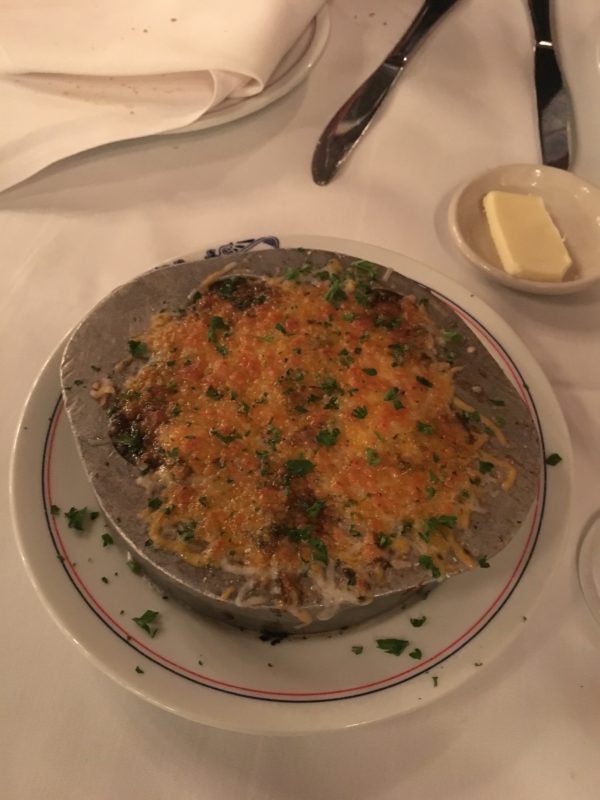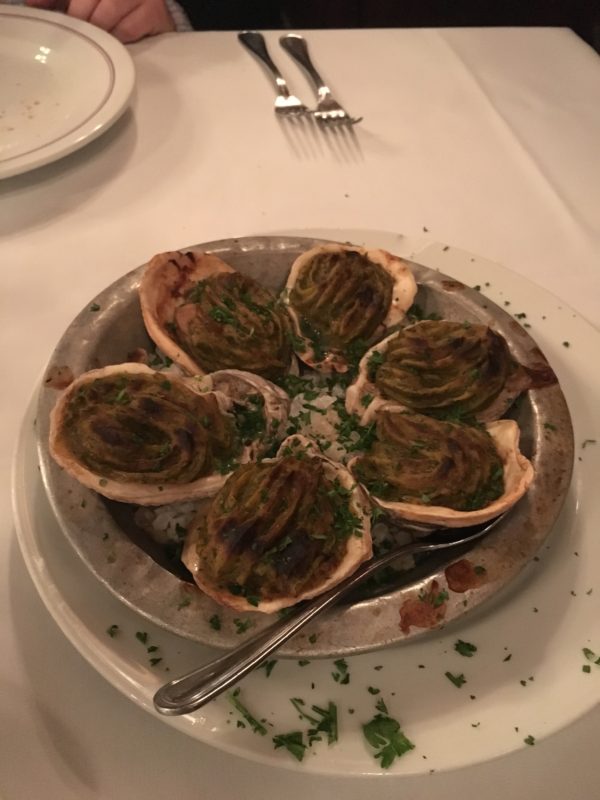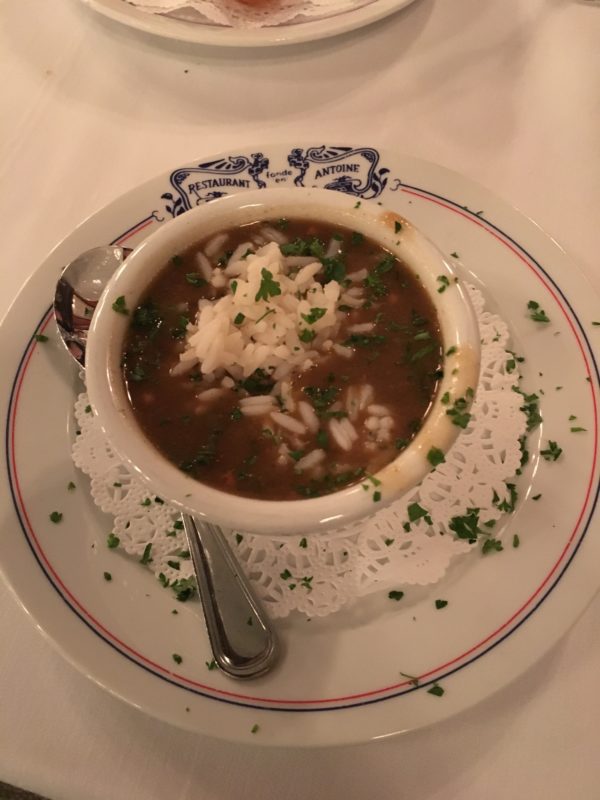Editor’s Note: The following series “Transplant in New Orleans” is a week-long series curated by Piper Stevens as part of the Digital Research Internship Program in partnership with ViaNolaVie. The DRI Program is a Newcomb Institute technology initiative for undergraduate students combining technology skillsets, feminist leadership, and the digital humanities.
New Orleans is a city overflowing with vibrancy and culture, and it defines a piece of each of its inhabitants. ”Transplant in New Orleans” takes a tour of some of my favorite spots in New Orleans and shares some history and insight into what makes these places, and the city as a whole, feel like home to someone who has only lived here for a few years. In a time when everything feels a little quieter and more distant, I hope these articles remind us of all there is to love about living in the city that care forgot.
Antoine’s restaurant is a true New Orleans fixture and a symbol of history and the cultural evolution of the city. The evolution of this 180 year old restaurant mirrors the cultural evolution of the city. Whether you eat the traditional Oysters Rockefeller invented in 1899 or gumbo in the restaurant’s Tobasco Room, anyone will enjoy the fusion of past and present embodied by Antoine’s. This article was originally published on February 5, 2018.
The year is 1840. New Orleans has yet to celebrate its 40th anniversary as a U.S. city, vibrant French speaking communities dominate high-culture, and a mix of people, both free and enslaved, coexists unlike anywhere else in the nation. It was in this context that Antoine Alciatore, an 18 year-old chef and French immigrant, established Antoine’s, the restaurant that would define dining in New Orleans for the next 175 years.
The evolution of the menu at Antoine’s in many ways mirrors the cultural evolution of the city of New Orleans, and, to a lesser extent, the cultural evolution of the greater United States. From its outset, Antoine’s was a strictly French restaurant tailored to French clientele. Originally opened in a small boarding house on St. Louis Street, Alciatore created his restaurant for the French gentility that lived around him. Escargot, rich butter sauces, and decadent beef dishes dominated the menu. Antoine’s offered French food–prepared in distinctly French techniques–to the French population within New Orleans, as would be expected given the demographic of the city.

Escargot a la Bordelaise
While not revolutionary in his idea, Alciatore excelled in the French classics and gained popularity among the French elite, enough so to move to a larger location in 1868 where the restaurant stands today.
However, as the turn of the century came, with Antoine’s son, Jules, now in charge of the restaurant, the United States was a vastly different country. Railroads covered the nation, the French population no longer dominated the city of New Orleans, and the era of industry reigned.
Invented in 1899 by Jules Alciatore, Oysters Rockefeller remains on the menu as a testament to the time of their conception. The dish seamlessly integrates fresh New Orleans’ seafood with French cooking techniques (namely copious amounts of butter) and memorializes the most famous family at the time of its invention.

Oysters Rockefeller
Enjoying the rich, butter infused, and charbroiled dish really does evoke images of a time when robber barons and industrial monopolies transformed American culture into one of decadence and extreme wealth. It is hard to think of any other dish that better represents the historical and cultural context of its creation. Antoine’s menu continues to evolve to this day as the city it serves continues to demand different items. Gumbo, an iconic creole dish that tourists to New Orleans have come to expect out of any representative dining establishment, now graces the menu alongside French classics like Soupe a l’oignon Gratinée (French Onion Soup).

Gumbo
Sherry wine-laced soups now include alligator meat, a novel New Orleans staple that excites visitors in its seemingly exotic origins despite its mild flavor. Possibly most representative of the ever evolving city and changing expectations of its customers, Antoine’s menu now offers English subtitles to its, until recently, strictly French menu.
Despite these apparent deviations from the original, Antoine’s remains a distinctly French restaurant within the city of New Orleans. Run by the same family for over 175 years, the changes to Antoine’s menu do not come at the whim of a constantly revolving group of employees, as is often the case with long lasting restaurants. Rather, they illustrate the natural evolution of a restaurant devoted to providing its clientele with the truest representation of French cuisine within New Orleans. This intense dedication to both tradition and city is undoubtedly one of the reasons Antoine’s has remained a favorite for so many years.
At no time is the link between Antoine’s and the city of New Orleans more apparent than during the celebration of Mardi Gras. Both the Mistick Krewe, widely recognized as the oldest krewe still in existence, and the Rex Organization, formed in 1872 and arguably the most influential organization/krewe on today’s parades, hold annual luncheons at Antoine’s in the week before official festivities begin.
As the decades have passed, these luncheons have transformed from secretive, cult-like affairs, to receptions for foreign dignitaries, and, finally, to the joyous, ceremonial occasions they are today. Like all other aspects of Antoine’s, Mardi Gras traditions evolve as the culture of New Orleans evolves. Mardi Gras has transformed into a nationwide “bucket list” celebration with hundreds of thousands of visitors coming every year. Reflecting this, the banquet for Krewe of Proteus now brings in the largest crowd in terms of Antoine’s Mardi Gras related festivities. Yet, as with all other aspects of the restaurant, a certain level of mystique and reverence is reserved for the smaller, more exclusive luncheons that have been meeting annually for nearly 150 years.
Originally opened as a small dining room in Alciatore’s boarding house, Antoine’s has since grown into a massive 14-room restaurant in the heart of the French Quarter. Just as changes in menu can be used to trace changes in the history of the city, the growth of the physical restaurant offers an interesting window through which to view the history of New Orleans.
Antoine’s acts as both a time machine and a mirror, with unmistakable relics of the past integrated with images of the present. Pictures of the biggest stars in Hollywood share the wall with politicians of the Cold War era and pop culture references from turn of the 20th century. Waiters in pristine white shirts and black bowties, a uniform that has scarcely changed for decades, combine French refinement and a dose of Southern hospitality to make each customer feel both comfortable and pampered.
Yet, the history behind Antoine’s distinct dining rooms serves as the most telling feature of the restaurants long and colored lifetime. The 1840 Room, given its name, is the clearest ode to the old Antoine’s restaurant. Fitted with time appropriate table setting and room décor, with the added touch of a Parisian cookbook dating back to 1659, the room offers visitors the chance to dine as many did nearly two hundred years ago. However, the Japanese Room and the Mystery Room are actually the most interesting cases in terms of historical development. Efforts in globalization and a growing Asian population within the United States created a nationwide artistic fascination with the East around the turn of the 20th century. Thus, the Japanese Room was born. When the Japanese bombed Pearl Harbor in 1941 this fascination turned to nationwide suspicion and condemnation. Antoine’s decided to close the room for the next 43 years until it reopened in 1985.
The Mystery Room, named for the manner in which alcohol was secretly transported through the restaurant, highlights another influential moment in the nation’s history: prohibition. Allegedly, the room through which diners would travel to receive coffee mugs full of bootleg alcohol, the room remains as a reminder of one of the now most popularly dramatized moments in U.S. history.
Whether eating escargot in the 1840 Room or enjoying gumbo in the Tobasco Room–the newest dining room dedicated to the Tobasco family of Louisiana–Antoine’s offers diners the option to enter a culturally unique time period in the history of New Orleans. Without being tacky or forced, as the restaurant has no need to fake the authenticity of the time period being showcased, Antoine’s exists as a culinary monument to what came before.
Antoine’s should be a stop for any visitor to New Orleans. The chance to view history through the lens of butter infused seafood is both delicious and extremely interesting. A testament to the past and an ever-changing reflection of the present, Antoine’s combines French culinary tradition with the unique cultural development of New Orleans to provide an unforgettable dining experience.
Sources:
“Carnival’s Reigning Restaurant – New Orleans Magazine – January 2015 – New Orleans, LA,” n.d. Accessed December 6, 2017.
“History of Antoine’s | Antoine’s Restaurant.” Accessed December 5, 2017. http://www.antoines.com/history.html.
 NOLAbeings Multimedia artist Claire Bangser created NOLAbeings as a portrait-based story project that marries...
NOLAbeings Multimedia artist Claire Bangser created NOLAbeings as a portrait-based story project that marries...  Voodoo in New Orleans: Reviving history: New Orleans fortune telling This article takes a deep dive into the history of Voodoo in New Orleans, its hybridization with Catholicism, and its present-day place in the city's culture. The author visits fortune-tellers in the French Quarter, using their guidance as a tool for introspection rather than a deterministic predictor of the future. Through her experiences in New Orleans, the author feels a mystical connection to both the past and the future.
Voodoo in New Orleans: Reviving history: New Orleans fortune telling This article takes a deep dive into the history of Voodoo in New Orleans, its hybridization with Catholicism, and its present-day place in the city's culture. The author visits fortune-tellers in the French Quarter, using their guidance as a tool for introspection rather than a deterministic predictor of the future. Through her experiences in New Orleans, the author feels a mystical connection to both the past and the future. 
[…] On our next stop of this culinary adventure, dinner might help find the reader at the world famous French-Creole Antoine’s Restaurant, or perhaps at the lesser known Saffron for Indian fare. Jack Lane highlights Antoine’s decadence as a part of Piper Stevens’s curation project “Transplant in New Orleans” originally published on November 16, 2020; Carol Pulitzer takes on covering the savory Saffron originally published on May 16, 2016. Here’s the piece on Antoine’s Restaurant. […]